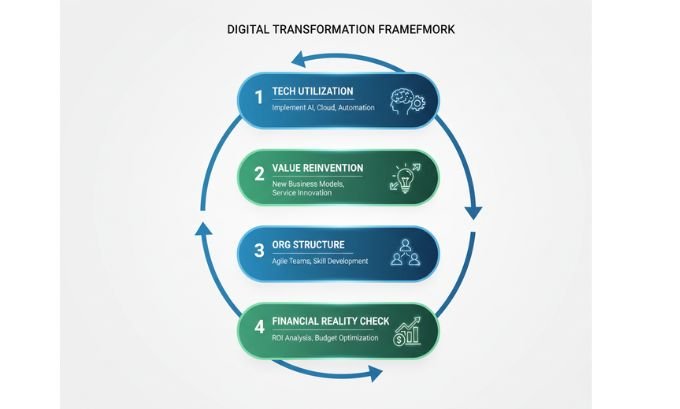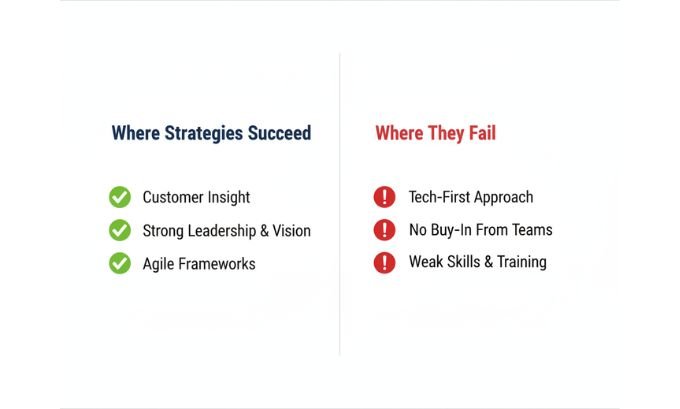What’s the secret behind the companies that don’t just survive but adapt and flourish in digital times? It’s not about chasing every shiny tool. The real winners are those with digital transformation strategies grounded in purpose, flexibility, and human needs. This article shares down-to-earth guidance, lived experiences, and critical takeaways—so your digital approach isn’t just talk, but real, lasting progress.
Table of Contents
Digital Transformation Strategies: What Really Matters?
Building a strong digital transformation strategy means much more than upgrading tech. It’s about weaving technology, people, and process together to deliver continuous value—while staying focused on what your customers actually need.
Why is this so important? The sheer speed of change, from Industry 4.0 advancements to global shifts like climate change, means businesses need strategies that flex and scale, not just flashy new tools.
Treat digital transformation as a living, evolving strategy that balances newer technologies (like Generative AI) with empathy and insight.
Building Blocks: The DNA of Effective Transformation

In a Nutshell: Great digital transformation doesn’t happen by accident—it relies on a structure designed for clarity and alignment.
Meet the Digital Transformation Framework (DTF). Think of it less as a rigid checklist and more as an adaptable playbook that brings together four essentials:
- Tech Utilization: Are you racing ahead at the cutting edge, or making smart moves as a fast follower?
- Value Reinvention: How will digital tools and data let you shape new products, rethink services, or even rewrite parts of your business model?
- Org Structure: Does your plan demand hiring a Chief Digital Officer (CDO), assembling cross-functional squads, or updating job roles?
- Financial Reality Check: How does transformation fit your budgets, ROI goals, and timelines for sustainable progress?
Skipping any core element weakens your strategy and puts meaningful change at risk.
Lived Experience: When Strategy Meets the Shop Floor
Theory is fine, but stories often cut deeper. Let’s meet someone navigating these waters right now.

The Fresh Eyes of a Leader: Gareth Walsh’s Story
Picture Gareth—leader of a busy engineering company. For years, business boomed by manufacturing custom components for other firms. When Gareth sensed new opportunities, he did what many do: upgraded machines, digitized, and embraced Industry 4.0. At first, results were promising, but soon he noticed something odd—while efficiency ticked up, core challenges and missed opportunities stuck around.
It was only when Gareth and his colleagues shifted energy to understand customer pain points—not just chase efficiencies—that real transformation began. Using frameworks like the Seven Principles of Digital Business Strategy Framework, they homed in on something urgent: clients (municipalities, city planners) facing rising flood risks thanks to climate change.
If you want to learn more about digital transformation strategies, you can visit gogonihon.jp.net, mindjournal.co or techbullion.in
Fast-Tracked Experiments: From Talk to Action Using Generative AI
With an open mind and a toolkit packed with AI and Large Language Models (LLMs), Gareth’s team did something new:
- Ran ultra-fast “what-if” tests on potential solutions and business models, using LLMs for scenario mapping.
- Designed and reworked products and service pitches in days—instead of months.
- Co-created with real customers, learning on the fly what landed, what flopped, and where the hidden barriers were.

That journey led them to pivot: rather than selling to slow-moving government, they launched an app- and kit-based approach for communities to band together and fund their own flood defenses.
Lesson: Digital transformation strategies only pay off when anchored in lived realities—customer needs, external trends, and the humility to adjust course quickly.
Recognizing and Avoiding the Common Pitfalls
Strengths Found in the Best Strategies
- Genuine Customer Understanding: The entire business aligns around authentic needs and pain points.
- Powered by Modern Tools: Rapid learning cycles are possible thanks to Generative AI and LLMs.
- Clear Leadership: A Chief Digital Officer (CDO) (or similar role) can bust silos and drive unified effort.
- Robust, Flexible Frameworks: Blending the strengths of the DTF and the Seven Principles avoids the blind spots of going it alone.

Areas Where Efforts Falter
- Chasing Hype Over Substance: Tech is only as good as the problems it solves and the value it adds.
- Underestimating Skill Shifts: Services and digital models create demand for new expertise and collaboration—not just new tech.
- Cultural Hurdles: Buy-in at every level is non-negotiable. Even the smartest plan falls flat if people aren’t on board.
Strategy in Motion: How the Key Entities Interact
Making sense of buzzwords is easier when you see how the pieces fit. Use this reference table to connect the moving parts:
| Entity / Concept | Purpose in Digital Transformation |
|---|---|
| Digital Transformation Strategy | Sets the overarching direction and intent |
| Digital Transformation Framework (DTF) | Blueprint to align priorities, people, and investments |
| Chief Digital Officer (CDO) | Orchestrates cross-functional execution |
| Generative AI / LLMs | Accelerate testing, prototyping, and learning |
| Industry 4.0 | The context: smart factories, data-driven ops, IoT |
| Customer Pain Points | Direct the focus for meaningful solutions |
| Climate Change | External driver redefining risks and opportunities |
| Seven Principles of Digital Business Strategy | Guiding framework for strategic alignment |
| Gareth Walsh | Illustrative case study of transformation in action |
For a real-world look at how digital strategies drive growth, explore LinkLuminous.com for expert marketing insights and TokyoMart.store for a thriving example of e-commerce success in Japan.
Frequently Asked Questions: Digital Transformation Strategies
1. How is a digital transformation strategy different from just buying digital tools?
A strategy is an integrated plan that connects technology to people, process, and long-term growth—not just a series of projects or purchases.
2. Should every business appoint a Chief Digital Officer?
While not mandatory, having a CDO or similar leader often breaks deadlocks, creates accountability, and helps unite scattered efforts.
3. Where do Large Language Models (LLMs) fit?
LLMs are business accelerators—helping you pressure-test ideas, model options, and learn faster, especially if you blend them with real data and ongoing customer feedback.
4. Isn’t Industry 4.0 enough for transformation?
No—upgrades like automation matter, but transformation only happens when new value is created for your customers and your business.
5. Why are environmental factors like climate change included?
Because change outside your business reshapes needs, risks, and opportunities inside your business. Smart, connected strategies are future-proofed.
6. How do you start if you lack budget or digital expertise?
Begin with your customers: map out what bugs them most, and tackle change in focused sprints using low-cost, test-and-learn AI approaches.
In Closing: Turning Insights into Results
Digital transformation strategies are about more than riding the next technology wave. They call for listening before leaping, experimenting over endless planning, and putting customer value above gadget envy. Use proven frameworks like the DTF to anchor your journey, and remember—technology becomes transformative only when aimed at real problems, not just implemented for its own sake.
Action Steps:
- Start conversations with your customers—not your competitors.
- Prioritize quick-win projects that build trust and keep momentum.
- Appoint the right leaders (CDO or equivalent) to bridge dreams with delivery.
- Use frameworks as living guides, always open to iteration and new learning.
About the Authors
Our writing team brings hands-on consulting, digital leadership, and project experience across multiple industries. We’ve watched transformations fizzle and also seen them ignite—so our insights blend practical lessons, current research, and a people-first commitment.
References
- Matt, C., Hess, T., & Benlian, A. (2015). Digital Transformation Strategies. Business & Information Systems Engineering, 57(5), 339–343.
- Ionology. (n.d.). The 7 Principles of Digital Business Strategy. (Accessed June 2024)
- Horlacher, A., & Hess, T. (2014). Der Chief Digital Officer. MedienWirtschaft, 11(3), 32-35.

